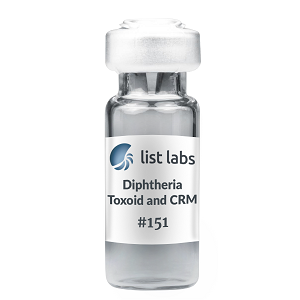Diphtheria Toxin
Diphtheria toxin (DT) is synthesized by certain strains of Corynebacterium diphtheriae and secreted as an inactive proenzyme, composed of a single polypeptide chain having an approximate molecular weight of 58 kDa. DT enzymatic activity is expressed when the proenzyme is nicked into two fragments, A and B, linked by a disulfide bond, then reduced with thiols releasing the N-terminal A fragment (molecular weight 21 kDa). The C-terminal B fragment (molecular weight 37 kDa) has no apparent enzymatic activity but is required for toxicity. Evidence suggests that the B fragment is responsible for recognizing and binding the toxin to cell surface receptors.
Diphtheria toxin catalyzes the ADP-ribosylation of eukaryotic aminoacyl-transferase II (EF-2) using NAD as a substrate, the basis for its toxicity toward eukaryotic organisms. Diphtheria toxin receptor (DTR) is a cell-surface expressed heparin-binding epidermal growth factor-like growth factor precursor (HB-EGF). In monkey cells, another membrane protein, CD-9 increases the affinity of diphtheria toxin for HB-EGF, indicating that two proteins may function together as a receptor.
Sensitivity of mammalian cell lines to diphtheria toxin varies with the presence of receptors. Monkey Vero cells are highly sensitive, hamster cells moderately sensitive, whereas rat and mouse cells without receptors are resistant. An injection of DT has relatively minor effects on normal mice and is used to selectively and transiently deplete the population of specific types of immune cells genetically attached with simian or human DTR. Use of DT in this way allows the normal development of the immune system followed by the selective elimination of specific cells. These studies allow conclusions about the function of the modified cells in various processes.
Diphtheria toxin preparations from C. diphtheriae Park Williams strain 8, are highly purified and unnicked. When followed by trypsin treatment and reduction with dithiothreitol, DT from List exhibits high specific activity. Diphtheria toxin is active on CHO19 or Vero20 cells when diluted to a nanogram or less per milliliter.
- Product #150 Diphtheria toxin, unnicked, from C. diphtheriae, is provided lyophilized in Tris buffer. As toxicity may vary by lot, each laboratory should determine the optimum dosage for each particular application.
Diphtheria Toxin CRM Mutant
Diphtheria toxin CRM Mutant (CRM 197) is a non-toxic, cross reactive DT mutant containing a lesion in the A chain blocking ADP-ribosylation. CRM results from a single base change in the structural gene resulting in the substitution of glutamic acid for glycine. While CRM shows no enzymatic activity, it is immunologically indistinguishable from diphtheria toxin.
In its applications, CRM 197 is similar to diphtheria toxoid. CRM has the advantage of being a well-defined protein in contrast to formaldehyde treated toxin (toxoid) which is non-specifically cross linked and subject to rearrangement. CRM functions as a carrier for polysaccharides and haptens, making them immunogenic.
Diphtheria toxin CRM Mutant preparations from C. diphtheriae are highly purified and migrate as a single major 58 kDa band when examined on SDS-PAGE.
- Product #149 Diphtheria toxin CRM Mutant is provided lyophilized in sodium phosphate buffer.




